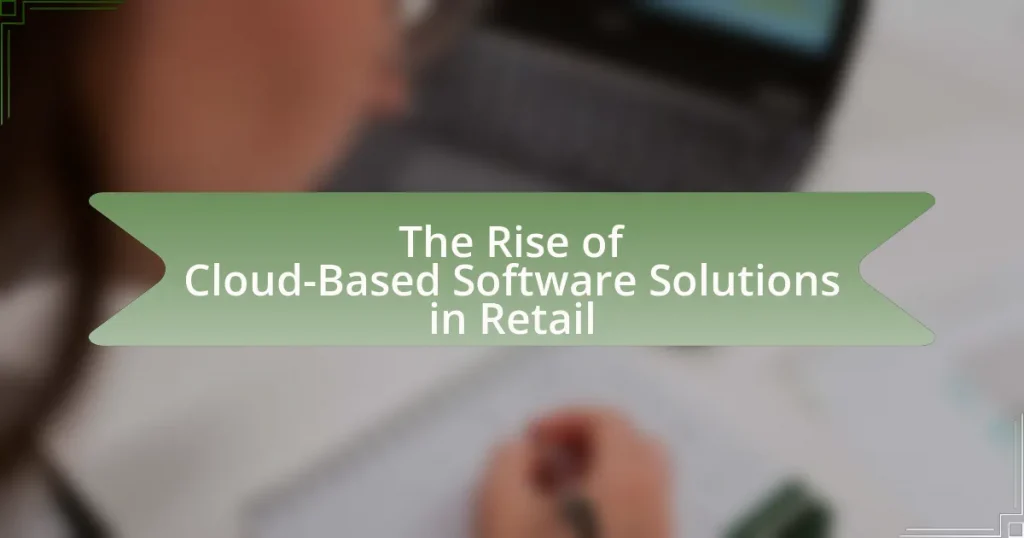The article focuses on the future of software retail, highlighting key trends such as the rise of subscription-based models, digital distribution, and the integration of artificial intelligence to enhance customer experiences. It examines the evolving consumer behavior favoring subscription services and digital access, driven by convenience and lower costs. Additionally, the article discusses the impact of technological advancements like cloud computing and AI on sales strategies, as well as the challenges posed by competition from open-source software and changing regulatory landscapes. Strategies for retailers to remain competitive, including optimizing customer engagement and leveraging data analytics, are also explored.
What are the key trends shaping the future of software retail?
The key trends shaping the future of software retail include the rise of subscription-based models, increased emphasis on digital distribution, and the integration of artificial intelligence for personalized customer experiences. Subscription-based models have gained traction, with companies like Adobe and Microsoft transitioning to Software as a Service (SaaS), resulting in predictable revenue streams and enhanced customer retention. Digital distribution has become dominant, as evidenced by the growth of platforms like Steam and the App Store, which facilitate instant access to software. Additionally, the use of artificial intelligence is transforming customer interactions, enabling tailored recommendations and improved customer service, as seen in companies leveraging AI chatbots and analytics to enhance user engagement.
How is consumer behavior evolving in software retail?
Consumer behavior in software retail is evolving towards increased preference for subscription models and digital distribution. This shift is driven by the convenience of accessing software without the need for physical media, as well as the growing trend of consumers valuing flexibility and lower upfront costs associated with subscriptions. According to a report by Statista, the global software as a service (SaaS) market is projected to reach $623 billion by 2023, indicating a significant consumer shift towards subscription-based services. Additionally, the rise of mobile applications and cloud computing has further influenced consumer expectations for instant access and seamless updates, reinforcing the trend away from traditional software purchasing methods.
What factors are influencing changes in consumer preferences?
Changes in consumer preferences are influenced by technological advancements, shifting societal values, and economic conditions. Technological advancements, such as the rise of mobile devices and e-commerce platforms, have made it easier for consumers to access and evaluate products. Shifting societal values, including increased emphasis on sustainability and ethical consumption, drive consumers to prefer brands that align with these values. Economic conditions, such as inflation or changes in disposable income, also affect purchasing decisions, as consumers may prioritize essential goods over luxury items. These factors collectively shape the evolving landscape of consumer preferences in the software retail sector.
How do subscription models impact purchasing decisions?
Subscription models significantly influence purchasing decisions by lowering the initial financial barrier for consumers. This model allows customers to access products or services for a recurring fee, which can lead to increased trial and adoption rates. Research indicates that 70% of consumers prefer subscription services due to their perceived value and convenience, as they often provide flexibility and lower upfront costs compared to traditional purchasing methods. Additionally, subscription models foster customer loyalty, as users are more likely to continue using a service they have already committed to financially, thus impacting long-term purchasing behavior.
What technological advancements are driving software retail?
Cloud computing is a key technological advancement driving software retail by enabling scalable and flexible access to software applications. This shift allows retailers to offer Software as a Service (SaaS) models, which have grown significantly; for instance, the global SaaS market is projected to reach $623 billion by 2023. Additionally, advancements in artificial intelligence and machine learning enhance customer personalization and inventory management, improving user experience and operational efficiency. The integration of blockchain technology also provides enhanced security and transparency in transactions, further influencing software retail dynamics.
How is artificial intelligence transforming software sales?
Artificial intelligence is transforming software sales by enhancing customer targeting, personalizing user experiences, and automating sales processes. AI algorithms analyze vast amounts of data to identify potential customers and predict their needs, leading to more effective marketing strategies. For instance, companies using AI-driven analytics have reported up to a 30% increase in conversion rates due to improved targeting. Additionally, AI chatbots and virtual assistants streamline customer interactions, providing instant support and recommendations, which can significantly boost customer satisfaction and retention. According to a report by McKinsey, businesses that leverage AI in sales can increase their productivity by 20% to 30%.
What role does cloud computing play in software distribution?
Cloud computing significantly enhances software distribution by enabling on-demand access to applications and services over the internet. This model allows software developers to deploy updates and new features rapidly, ensuring users always have the latest version without manual installations. According to a report by Gartner, the global public cloud services market is projected to grow to $397.4 billion in 2022, illustrating the increasing reliance on cloud-based solutions for software distribution. This shift not only reduces costs associated with physical media and distribution logistics but also improves scalability and accessibility for users across various devices and locations.
What challenges will software retailers face in the next decade?
Software retailers will face significant challenges in the next decade, primarily due to increasing competition from subscription-based models and the rise of open-source software. As consumers shift towards subscription services, traditional retail models that rely on one-time purchases will struggle to maintain profitability. According to a report by Gartner, the global software market is expected to grow to $1 trillion by 2025, but this growth will be largely driven by subscription services, which can undermine the sales of traditional software retailers. Additionally, the proliferation of open-source alternatives offers consumers cost-effective solutions, further intensifying competition. Retailers will need to adapt their business models and strategies to remain relevant in this evolving landscape.
How will competition evolve in the software retail market?
Competition in the software retail market will evolve through increased digitalization and the rise of subscription-based models. As consumers increasingly prefer on-demand access to software, traditional one-time purchase models will decline, leading to a shift towards services that offer continuous updates and support. This transition is evidenced by the growth of companies like Adobe and Microsoft, which have successfully adopted subscription models, resulting in a significant increase in recurring revenue streams. Additionally, the emergence of cloud computing and mobile applications will intensify competition, as new entrants can easily disrupt established players by offering innovative solutions at lower costs.
What strategies can retailers adopt to stay competitive?
Retailers can adopt strategies such as enhancing customer experience, leveraging technology, and optimizing supply chain management to stay competitive. Enhancing customer experience involves personalizing interactions and providing exceptional service, which can lead to increased customer loyalty and repeat business. Leveraging technology, including e-commerce platforms and data analytics, allows retailers to better understand consumer behavior and streamline operations. Optimizing supply chain management ensures that retailers can respond quickly to market demands and reduce costs, ultimately improving profitability. These strategies are supported by industry trends indicating that retailers focusing on customer-centric approaches and technological integration are more likely to succeed in a rapidly evolving market.
How will open-source software impact traditional retail models?
Open-source software will significantly disrupt traditional retail models by lowering entry barriers and fostering innovation. Retailers can leverage open-source solutions to reduce costs associated with proprietary software, enabling them to allocate resources more effectively towards customer experience and operational efficiency. For instance, companies like Walmart have adopted open-source technologies to enhance their supply chain management, resulting in improved inventory accuracy and reduced operational costs. This shift not only democratizes access to advanced technological tools but also encourages collaboration among retailers, leading to more agile and responsive business practices.
What regulatory changes might affect software retail?
Regulatory changes that might affect software retail include data privacy laws, intellectual property regulations, and consumer protection legislation. For instance, the General Data Protection Regulation (GDPR) in Europe imposes strict rules on how companies handle personal data, which can impact software retailers’ marketing and sales strategies. Additionally, changes in copyright laws can influence how software is distributed and protected, potentially affecting pricing and availability. Consumer protection laws may also evolve, requiring software retailers to provide clearer information about product features and pricing, thereby impacting their sales practices.
How can retailers prepare for potential data privacy laws?
Retailers can prepare for potential data privacy laws by implementing robust data governance frameworks. Establishing clear policies for data collection, storage, and usage ensures compliance with evolving regulations. For instance, the General Data Protection Regulation (GDPR) in Europe mandates transparency and user consent, which retailers can address by enhancing their privacy notices and obtaining explicit consent from customers. Additionally, investing in data protection technologies, such as encryption and access controls, can safeguard sensitive information and mitigate risks associated with data breaches. Regular training for employees on data privacy practices further strengthens compliance efforts, as informed staff are crucial in adhering to legal requirements.
What are the implications of international trade policies on software sales?
International trade policies significantly impact software sales by influencing market access, pricing, and regulatory compliance. For instance, tariffs on software products can increase costs for consumers and reduce demand, while trade agreements can facilitate easier access to foreign markets, enhancing sales opportunities. Additionally, differing regulations across countries regarding data privacy and intellectual property can create barriers for software companies, necessitating adaptations in their products and marketing strategies to comply with local laws. According to a report by the International Trade Administration, software exports from the United States reached $66 billion in 2020, highlighting the importance of favorable trade policies in sustaining growth in this sector.
What opportunities exist for innovation in software retail?
Opportunities for innovation in software retail include the integration of artificial intelligence for personalized customer experiences, the adoption of subscription-based models for continuous revenue, and the enhancement of user interfaces through augmented reality. AI can analyze consumer behavior to tailor recommendations, increasing sales and customer satisfaction. Subscription models, which accounted for over 60% of software revenue in 2022, provide predictable income and foster customer loyalty. Augmented reality can improve product demonstrations, allowing customers to visualize software applications in real-world scenarios, thereby enhancing engagement and decision-making.
How can retailers leverage data analytics for better sales?
Retailers can leverage data analytics for better sales by utilizing customer insights to optimize inventory management and personalize marketing strategies. By analyzing purchasing patterns and customer preferences, retailers can forecast demand more accurately, reducing excess stock and minimizing stockouts. For instance, a study by McKinsey & Company found that retailers using advanced analytics can increase their operating margins by 60% through improved inventory turnover and targeted promotions. This data-driven approach enables retailers to tailor their offerings, enhance customer experiences, and ultimately drive higher sales.
What types of data should retailers focus on collecting?
Retailers should focus on collecting customer behavior data, sales data, inventory data, and demographic data. Customer behavior data, such as purchase history and browsing patterns, helps retailers understand preferences and tailor marketing strategies. Sales data provides insights into product performance and seasonal trends, enabling better inventory management. Inventory data ensures optimal stock levels and reduces waste, while demographic data allows for targeted marketing efforts based on age, gender, and location. Collectively, these data types enhance decision-making and improve customer experiences, ultimately driving sales growth.
How can predictive analytics enhance customer experiences?
Predictive analytics enhances customer experiences by enabling businesses to anticipate customer needs and preferences. By analyzing historical data and identifying patterns, companies can tailor their offerings, improve service delivery, and personalize marketing efforts. For instance, a study by McKinsey & Company found that organizations using predictive analytics can increase customer satisfaction by up to 10% and boost sales by 5-10% through targeted recommendations and timely interventions. This data-driven approach not only fosters customer loyalty but also optimizes operational efficiency, ultimately leading to a more satisfying customer journey.
What role does customer engagement play in future software retail?
Customer engagement will be crucial in shaping the future of software retail by driving customer loyalty and enhancing user experience. Engaged customers are more likely to make repeat purchases, as evidenced by a study from Bain & Company, which found that increasing customer retention rates by just 5% can increase profits by 25% to 95%. Furthermore, effective customer engagement strategies, such as personalized marketing and responsive customer service, can lead to higher customer satisfaction and advocacy, ultimately influencing purchasing decisions and brand perception in the competitive software market.
How can retailers utilize social media for marketing software?
Retailers can utilize social media for marketing software by creating targeted advertising campaigns that leverage user data to reach specific demographics. This approach allows retailers to tailor their messaging and promotions based on user interests and behaviors, increasing engagement and conversion rates. For instance, according to a 2021 report by Hootsuite, 73% of marketers believe that social media marketing has been effective for their business, highlighting the platform’s potential for driving software sales. Additionally, retailers can engage with customers through interactive content, such as polls and live demonstrations, which fosters community and enhances brand loyalty.
What are effective strategies for building customer loyalty?
Effective strategies for building customer loyalty include providing exceptional customer service, creating personalized experiences, and implementing loyalty programs. Exceptional customer service fosters trust and satisfaction, leading to repeat business; studies show that 70% of customers are willing to pay more for better service. Personalized experiences, such as tailored recommendations based on purchase history, enhance customer engagement and retention, with research indicating that 80% of consumers are more likely to make a purchase when brands offer personalized experiences. Loyalty programs incentivize repeat purchases and can increase customer retention rates by up to 30%, as they reward customers for their continued patronage.
What best practices should software retailers adopt for success?
Software retailers should adopt a customer-centric approach, focusing on understanding and meeting the needs of their target audience. This involves leveraging data analytics to gain insights into customer preferences and behaviors, which can inform product offerings and marketing strategies. Additionally, retailers should prioritize seamless user experiences across all platforms, ensuring that purchasing processes are intuitive and efficient.
Implementing robust customer support systems is also crucial, as timely assistance can enhance customer satisfaction and loyalty. Furthermore, retailers should embrace digital transformation by integrating emerging technologies, such as artificial intelligence and machine learning, to optimize inventory management and personalize marketing efforts.
According to a report by McKinsey & Company, companies that prioritize customer experience can achieve revenue growth rates of 4-8% above their market average, highlighting the importance of these best practices for long-term success in the software retail industry.
How can retailers optimize their online presence for sales?
Retailers can optimize their online presence for sales by enhancing website usability, implementing effective SEO strategies, and utilizing data analytics for targeted marketing. Improved website usability, including fast loading times and mobile responsiveness, leads to higher customer satisfaction and conversion rates. Effective SEO strategies, such as keyword optimization and quality content creation, increase visibility in search engine results, driving more traffic to the site. Utilizing data analytics allows retailers to understand customer behavior and preferences, enabling personalized marketing efforts that can significantly boost sales. According to a study by HubSpot, companies that prioritize blogging are 13 times more likely to achieve a positive ROI, demonstrating the impact of content marketing on sales.
What are the key elements of a successful software retail strategy?
The key elements of a successful software retail strategy include a strong online presence, effective customer engagement, competitive pricing, and robust distribution channels. A strong online presence is essential as it allows retailers to reach a broader audience; for instance, 70% of consumers research products online before purchasing. Effective customer engagement through personalized marketing and support enhances customer loyalty and satisfaction, which is critical in a competitive market. Competitive pricing strategies, including discounts and bundling, attract price-sensitive customers, while robust distribution channels ensure that software is readily available to consumers, whether through digital downloads or physical copies. These elements collectively contribute to a successful software retail strategy by addressing consumer needs and market dynamics.



